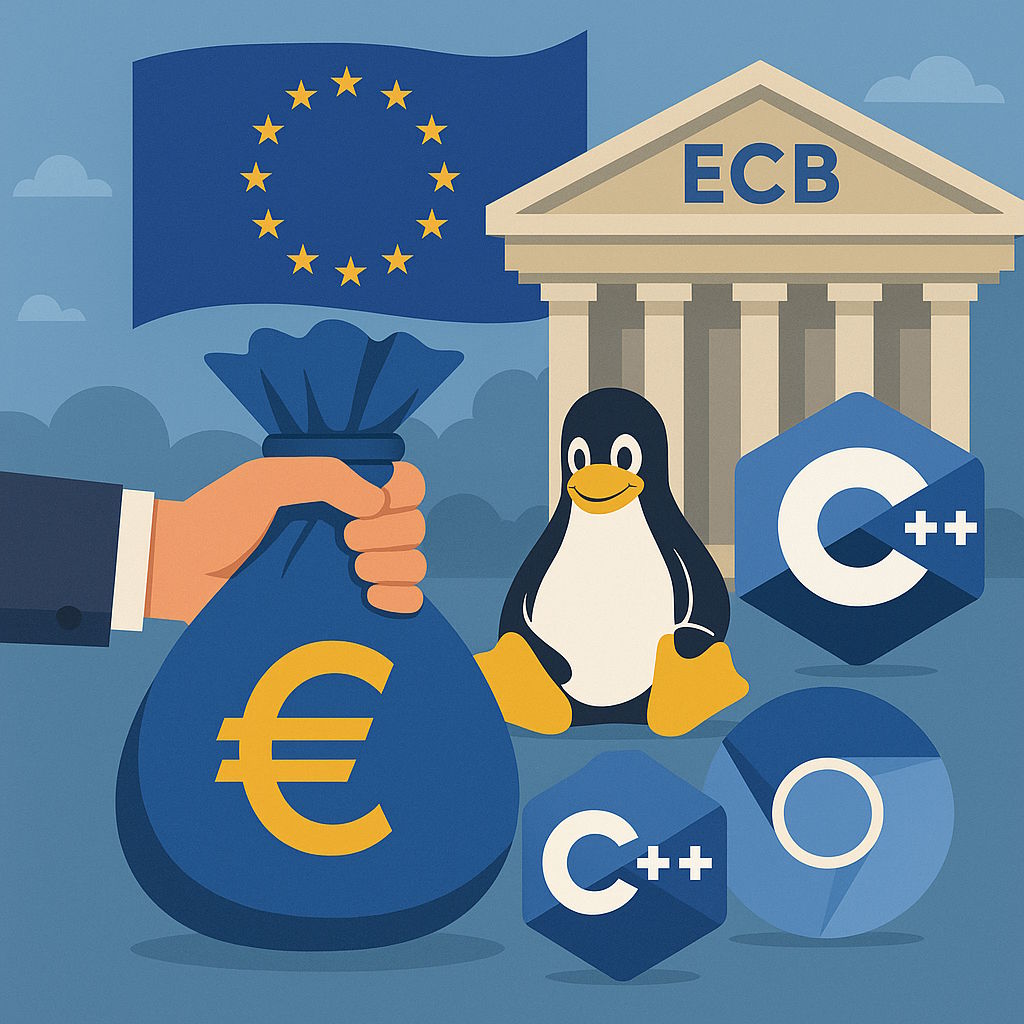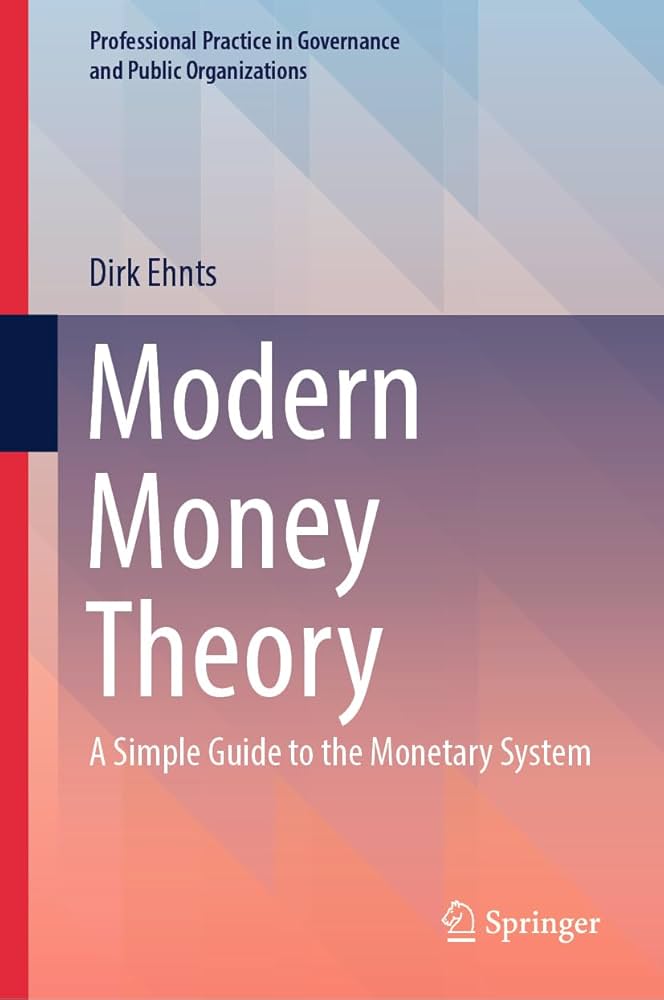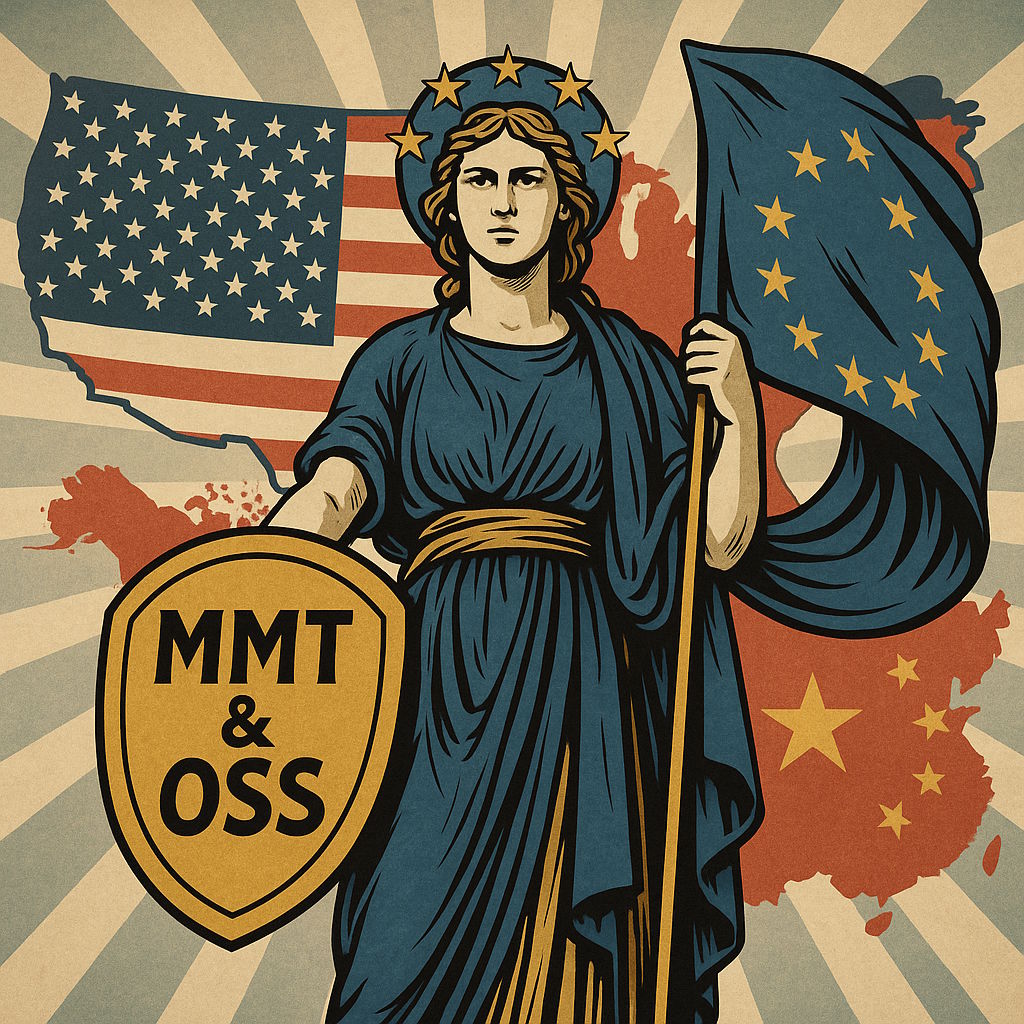The MMT Case for Governments Funding Open Source Software
Marton Trencseni - Tue 07 October 2025 - Economics
Introduction
Why digital infrastructure deserves public investment, just like roads, hospitals, and schools.
Modern society runs on open source software (OSS). Linux powers the internet. OpenSSL secures global commerce. Python enables vast amounts of scientific and business analytics. SQLite is embedded in billions of devices. Yet the developers maintaining these projects are often underfunded, underappreciated, or working nights and weekends to keep critical infrastructure alive. Governments routinely fund physical infrastructure, public healthcare, education, and pensions—long-term investments in collective well-being. But when it comes to the digital commons, the default assumption is that it will take care of itself through volunteerism, foundations, or the goodwill of corporations.
Modern Monetary Theory (MMT) provides a useful lens to reframe this. MMT shifts the debate from “How will we pay for it?” to “Is this a worthy use of public resources?” Once you look at OSS through that lens, the case for direct government funding of open source software becomes compelling.

A Primer on Modern Monetary Theory
MMT is best understood not as a radical new idea, but as a different way of describing how sovereign monetary systems already work. It starts with a simple but powerful observation:
A government that issues its own fiat currency cannot “run out” of money in the way a household or company can.
Most public debates treat governments as if they were large households: they collect taxes (income), then they spend (expenses), and if expenses exceed income they must borrow. Under this view, persistent deficits are alarming because they suggest the government is “living beyond its means.” MMT inverts this picture. In a fiat currency system—like those of the US, UK or Japan—a government spends first by issuing new currency, and taxes later, to withdraw some of that currency back. It doesn’t need to “find” the money; it creates the money when it spends.
When the government spends, it instructs its central bank to credit the reserve accounts of commercial banks, which then credit the deposits of whoever receives the payment. New money is created at that moment. When the government taxes, the opposite happens: the payer’s bank account is debited, the bank’s reserves are debited, and the tax liability is extinguished. The money disappears from circulation. This leads to a counterintuitive but crucial insight: government spending injects money into the economy, taxation deletes it. Government bonds fit into this picture not as a way of “funding” spending, but as a monetary policy operation. When the government sells bonds, it is essentially swapping one form of liability (bank reserves) for another (government securities) to manage interest rates and provide a safe asset to investors. For a monetary sovereign, issuing bonds is a choice, not a necessity. It cannot be forced to default on debt denominated in its own currency—it can always create the currency to pay.
Once you understand these mechanics, the real constraint on government spending becomes clear: it’s not about money, it’s about real resources. How many people are available to work? How much productive capacity is idle? Are there enough materials, skills, and infrastructure to support the project? If the government spends too much into an economy that is already at full capacity, it will cause inflation, because there are no real resources left to absorb the new spending. But if the economy has slack—unemployed people, underused factories, neglected sectors—then government spending can mobilize those idle resources without causing inflation. This is the core MMT argument: governments should focus on real constraints (labor, materials, capacity), not artificial financial ones (budgets, deficits), when deciding how much to spend.
If spending comes first, what is the purpose of taxation? MMT identifies several key roles for taxes:
- Creating demand for the currency, since people must pay taxes in the government’s currency
- Controlling inflation by withdrawing purchasing power from the private sector
- Shaping distribution and behavior through tax policy.
Taxes don’t fund spending in the mechanical sense—they don’t fill the pot. Rather, they create the space for the government to spend without triggering inflation.
MMT distinguishes between vertical transactions (between the government and the non-government sector) and horizontal transactions (between entities within the non-government sector, such as households, firms, and banks). Vertical transactions create or destroy net financial assets for the private sector. When the government runs a deficit, it’s adding net financial assets to the economy; when it runs a surplus, it’s draining them. Horizontal transactions redistribute or expand credit within the private sector, but they net to zero overall—one person’s asset is another’s liability. This distinction clarifies why persistent government deficits are not necessarily problematic: they are often the mirror image of private sector net saving. If the private sector wants to accumulate safe financial assets, the government must run deficits to supply them.
This is formalized in the sectoral balances identity:
(Government Balance) + (Private Domestic Balance) + (Foreign Balance) = 0
If the government runs a surplus, either the private sector or the foreign sector must run a deficit. Conversely, if the private sector wants to run a surplus (save more than it invests), the government must be in deficit unless the country runs a large trade surplus. This is why austerity policies often lead to private sector deleveraging crises—they force the private sector to run deficits to maintain aggregate demand.
One practical proposal often associated with MMT is the Job Guarantee. The idea is that the government should offer employment at a fixed nominal wage to anyone willing and able to work. This program would act as a buffer stock of employed labor: when private demand weakens, workers flow into the Job Guarantee; when private demand strengthens, they move out. This stabilizes incomes, provides useful public services, and serves as a nominal anchor for wages. The Job Guarantee embodies the MMT principle of using fiscal capacity to mobilize idle resources—in this case, labor—in pursuit of public purpose, rather than leaving people unemployed in the name of arbitrary budget targets.
MMT doesn’t claim governments can spend infinitely without consequences. It says the binding constraint is inflation, not insolvency. The challenge for policymakers is to align spending with real capacity. When inflation pressures arise, the appropriate response is to adjust taxes, reduce or redirect spending, or expand real capacity—not to impose artificial financial limits like debt ceilings. None of this is “free money.” It’s a reframing of the sequence of operations and the nature of constraints. MMT doesn’t propose that governments print money to solve every problem; it proposes that governments recognize their true capacities and constraints. In practice, this means evaluating spending proposals based on real resource availability and public purpose, not on budget lines or bond vigilantes.
This reframing allows us to ask: What projects would truly improve collective well-being? Do we have the real capacity to do them? If so, why aren’t we doing them? Once the artificial “how will we pay for it?” barrier is removed, new categories of investment become possible—including digital public goods like open source software.
For a more detailed discussion on MMT, see the excellent recent book by Dirk Ehnts' Modern Money Theory: A Simple Guide to the Monetary System:

Open Source Software as a Digital Public Good
Under MMT, the purpose of public spending is not to balance the budget, but to advance public purpose. If there’s unused capacity in the economy, governments can and should deploy fiscal power to fund worthwhile projects. This spending can be direct—for example, hiring nurses, teachers, or engineers—or indirect, by funding organizations, grants, or infrastructure projects. The key is that the spending should be aimed at real value creation with broad social benefits. Typical examples include the green energy transition, national infrastructure upgrades, or basic research. But once you accept the MMT framing, the category of “worthy public projects” can expand significantly.
To ground this, consider the kinds of projects governments already fund under traditional frameworks: physical infrastructure such as roads, bridges, power grids, public transport, and water systems; human infrastructure such as public healthcare, education from early schooling through universities, and pensions; scientific research and innovation; broadband and telecommunications infrastructure; and environmental protection. All of these are investments in public goods—non-rivalrous, broad-benefit goods that markets tend to underprovide.
Open source software has the classic features of a public good: it is non-rivalrous, non-excludable, and generates massive positive externalities. Much of the world’s digital economy depends on OSS: operating systems, compilers, cryptographic libraries, programming languages, databases, web servers. Corporations, startups, universities, and governments all rely on this infrastructure every day. Yet many foundational OSS projects are maintained by small, underfunded teams. Sometimes it’s a few volunteers. Sometimes it’s a nonprofit foundation living on donations. Occasionally a corporation steps in—but often for narrow, self-interested reasons.
From an MMT perspective, the logic is straightforward: if a project provides large, widely shared benefits and is underprovided by markets, the government can step in and fund it directly. It’s the same logic used for roads, research labs, and public universities—just applied to digital infrastructure.
It should be pointed out that governments already support some open source projects indirectly. Many researchers, university staff, and public-sector technologists contribute to open source in the course of their work, and some projects—like the Linux kernel—benefit from a healthy mix of corporate and public involvement. National labs, research grants, and defense programs have all, at times, seeded important contributions to compilers, operating systems, and scientific libraries. In that sense, public funding for OSS isn’t a completely foreign idea; it’s happening in scattered, organic ways already.
The problem is that this support is fragmented, incidental, and concentrated in a few exceptional projects. Contributions often depend on individual departments or temporary grants, not on a coordinated, long-term strategy. Many critical but less visible projects—cryptographic libraries, infrastructure tools, or numerical foundations—fall through the cracks entirely. Even flagship projects rely heavily on corporate priorities, which can shift abruptly. The case here is not that OSS is unfunded, but that current funding is uneven and fragile, and that a strategic, stable public investment approach could strengthen the entire digital commons—not just its most visible peaks.
Open Source Projects Worth Funding
When discussing public funding for open source software, it’s tempting to produce a neat list of “projects governments should fund.” That misses the deeper point. The goal is not to pick winners based on GitHub stars or hype cycles, but to recognize that some categories of software are so fundamental to modern life that they should be treated as digital common goods—infrastructure that must remain stable, secure, and well maintained over the long term. Identifying exactly which projects qualify is a complex task in itself, involving technical judgment, governance, and prioritization. Solving that prioritization and allocation problem is beyond the scope of this article, but it’s still useful to sketch the kinds of areas where public funding could make a decisive difference.
Some prominent projects like the Linux kernel, compilers for major languages, or Chromium already have relatively healthy ecosystems, supported by a mix of corporations, universities, and volunteers. They illustrate the kind of foundational role open source can play in the economy, but they are not necessarily the most urgent funding targets. The real gaps often lie elsewhere: in smaller but critical components that lack institutional backing; in legacy libraries that need modernization to meet current security and performance standards; and in the “boring” infrastructure—build systems, cryptographic toolkits, package managers, reproducibility tooling—that quietly underpins everything else. Projects like OpenSSL, SQLite, NumPy, or supply chain security tooling have all shown how fragile the ecosystem can be when key components depend on a handful of under-resourced maintainers.
Instead of focusing on specific repositories, it’s more useful to think in terms of systemic categories and look for resource and funding gaps:
- operating system and runtime foundations
- compilers and core developer tooling
- cryptographic and security libraries
- numerical and scientific computing layers
- desktop environments and browsers as universal interfaces
These are the digital equivalents of roads, power grids, or water systems—critical shared assets that the market tends to underfund because their benefits are diffuse and non-excludable. They’re not startups waiting for VC; they’re infrastructure.
Public investment here wouldn’t replace the vibrant communities that created these projects. Rather, it would stabilize and extend them: funding maintenance, modernization, audits, documentation, and the kind of long-horizon work that rarely fits corporate priorities. In some cases, that might mean supporting already healthy ecosystems to give them more predictable backing; in others, it would mean identifying and shoring up neglected but critical layers that have no natural funding base at all. The key is not to draw up a shopping list, but to recognize that a structured, strategic approach to funding the digital commons is needed—one that reflects the scale and importance of the infrastructure at stake.
A Strategic Opportunity for the European Union
This kind of public investment in digital commons doesn’t have to happen at the level of individual nations. The European Union is particularly well-suited to take the lead. The EU often finds itself squeezed between the two dominant technology poles of the 21st century: the United States, with its powerful private tech giants, and China, with its state-backed digital ecosystems. Europe has world-class research institutions, a vibrant but fragmented tech sector, and strong regulatory capacity—but it often lacks unified industrial scale in key digital technologies. Funding and stewarding open source software could be one of Europe’s key strategic levers.
The EU already understands the value of shared infrastructure. It built the Schengen area, the Single Market, and pan-European transportation and energy projects. The same logic can apply to digital infrastructure. A coordinated funding program for critical open source projects—Linux, cryptography, compilers, browsers, desktop environments, scientific computing foundations—would give Europe technological sovereignty in key layers of the stack. Rather than duplicating Silicon Valley or Shenzhen, Europe can own the commons: fund the software everyone depends on, and ensure it evolves in ways that reflect European values of privacy, interoperability, and public interest.
This is not charity; it’s industrial policy. Stable, well-funded open source infrastructure would directly strengthen European startups, SMEs, and research groups by giving them a secure, modern, and open digital base to build on. It would reduce dependence on proprietary platforms and cloud ecosystems dominated by US and Chinese firms, lowering strategic vulnerabilities. Moreover, public investment in OSS would amplify Europe’s innovation capacity. Instead of trying to compete in every consumer product category, Europe could excel in building and maintaining the digital roads and bridges that everyone else uses—becoming a key shaper of standards, security, and interoperability globally. A pan-European, MMT-informed funding program, aimed at systematically supporting critical OSS infrastructure, could become a pillar of Europe’s digital strategy—a third way between corporate dominance and state monopolies.

Conclusion
Modern Monetary Theory teaches us that sovereign governments have the fiscal capacity to fund what matters, as long as real resources are available and the spending is directed toward public purpose. Open source software is digital infrastructure—as essential in the 21st century as roads, hospitals, and schools were in the 20th. Funding OSS is not charity. It’s strategic investment in the foundations of the digital economy: security, resilience, innovation, and long-term productivity. It’s a way to use public spending to shore up critical systems that the private sector has little incentive to maintain.
If governments can fund the roads that connect our cities, they can fund the code that connects the world.